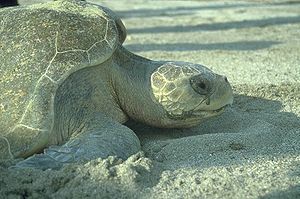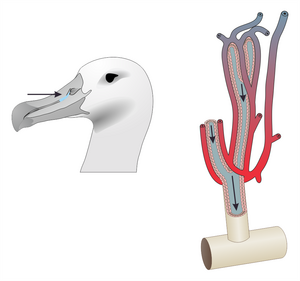Salt gland

Thesalt glandis anorganfor excreting excesssalts.It is found in the cartilaginous fishes subclasselasmobranchii(sharks, rays, and skates),seabirds,and somereptiles.Salt glands can be found in therectumof sharks. Birds and reptiles have salt glands located in or on the skull, usually in the eyes, nose, or mouth. These glands are lobed containing many secretorytubuleswhich radiate outward from the excretory canal at the center. Secretory tubules are lined with a single layer ofepithelial cells.The diameter and length of these glands vary depending on the salt uptake of the species.[1]
Salt glands maintainsalt balanceand allow marine vertebrates to drinkseawater.[2]Active transportviasodium–potassium pump,found on thebasolateral membrane,moves salt from thebloodinto the gland, where it is excreted as a concentratedsolution.
In birds[edit]


The avian salt gland has two main ducts: a medial and a lateral. Salt gland activations occurs from increased osmolarity in the blood, stimulating the hypothalamic information processing, sending a signal through theparasympathetic nerveactivatingvasodilation,the release of hormones (acetylcholine and vasoactive intestinal peptide).[3]Acetylcholinebinds to the receptor on the basolateral membrane of the gland. This in turn activates calcium release in the epithelial cells, opening potassium channels (flowing potassium out of the cells) on the basolateral membrane and chloride channels on the apical membrane to flow out of the cell. Ions are moved into the epithelial cells by aNa-K-Cl cotransporter,also in the basolateral membrane. Increases in sodium opens the sodium-potassiumATPasechannels, removing the excess sodium back out across the basolateral membrane and allowing for potassium to come into the cell. An electrical gradient is formed from the chloride ions, allowing sodium to be passed through thetight junctionsof the epithelial cells into the salt gland along with minimal amounts of water. As well, mitochondria-rich cells are associated with changes in salt concentration, increasing with higher amounts and decreasing with lower exposure, assisting in the movement of salts. These glands excrete thehypertonicsodium-chloride (with few other ions) by the stimulus of central and peripheralosmoreceptorsand volume receptors.
Thesupraorbital glandis a type of lateral nasal gland found in some species of marine birds, particularlypenguins,which removessodium chloridefrom the bloodstream. The gland's function is similar to that of the kidneys, though it is much more efficient at removing salt, allowing penguins to survive without access to fresh water. The supraorbital gland is also possessed by theEuropean herring gull- allowing the seagull to drink seawater without becoming ill, although it prefers to drink fresh water when available.[4]Contrary to popular belief, the gland does not directly convert saltwater to freshwater. The termsupraorbitalrefers to the area just above the eye socket (which is known as theorbit).
Living in saltwater environments would naturally pose a large problem for penguins because the ingestion ofsaltwaterwould be detrimental to a penguin's health. Although penguins do not directly drink water, it is taken in when they engulfprey.As a result, saltwater enters their system and must be effectivelyexcreted.The supraorbital gland has thus enabled the penguins' survival in such environments due to its water-filtering capability. The gland is located just above the eyes and surrounds acapillary bedin the head. This capillary bed constantly strains out the salt in the saltwater that a penguin takes in. Since the byproduct of the gland has roughly five times as much salt as would normally be found in the animal's fluids, the supraorbital gland is highly efficient.
The penguin excretes the salt byproduct as abrinethrough itsbill.Often, the fluid drips out, and this gives the appearance of a runny nose. However, the fluid may also besneezedout. In the absence of saltwater, caused by captivity, the supraorbital gland will lie dormant as it has no other purpose. Having a dormant supraorbital gland does not negatively affect the health of a penguin.
In reptiles[edit]
The need for salt excretion in reptiles (such asmarine iguanasandsea turtles) and birds (such aspetrelsandalbatrosses) reflects their having much less efficientkidneysthan mammals.[5]Unlike theskinofamphibians,that of reptiles and birds is impermeable to salt, preventing its release.[6]
The evolution of a salt gland in early reptiles and birds allowed them to eat aquatic plants and animals with high salt concentrations. This evolutionary development does not account for the gland inelasmobranchs,suggestingconvergent evolution.
Some theories suggestmammaliantear ductsandsweat glandsmay be evolutionarily related to salt glands. While human tears are high inpotassium,mostphylogeneticistsdisagree with the association.[citation needed]
See also[edit]
References[edit]
- ^Ellis, Richard A.; GOERTEMILLER, CLARENCE C.; STETSON, DAVID L (1982). "Significance of extensive /'leaky/' cell junctions in the avian salt gland".Nature.268(5620): 555–556.Bibcode:1977Natur.268..555E.doi:10.1038/268555a0.PMID887174.S2CID28638773.
- ^O’Driscoll, K.J.; Staniels, L.K.; Facey, D.E."Osmoregulation and Excretion".Archived fromthe originalon 8 July 2007.Retrieved6 July2007.
- ^Hildebrandt, Jan-Peter (2001). "Coping with excess salt: adaptive functions of external osmoregulatory organs in vertebrates".Zoology.104(3–4): 209–220.doi:10.1078/0944-2006-00026.PMID16351835.
- ^Dewey, Tanya; Spencer, Shane."ADW: Larus argentatus: INFORMATION".Animal Diversity Web.Retrieved8 April2023.
- ^"Plants Poisonous to Livestock - Cornell University Department of Animal Science".Ansci.cornell.edu.Retrieved14 July2011.
- ^Hazard, Lisa C. (2004). "Sodium and Potassium Secretion by Iguana Salt Glands".Iguanas: Biology and Conservation.University of California Press. pp. 84–85.ISBN978-0-520-23854-1.
Further reading[edit]
- Evans, D. H. 1993.Osmotic and Ionic Regulation.pp. 315–336. In Evans, D. H. 1993. The Physiology of Fishes. CRC Press, Boca Raton, Florida.
- Goldstein, D. L. 2002.Water and Salt Balance in Seabirds.pp. 467–480. In Schreiber, E. A. and J. Burger. (eds.) 2002. Biology of Marine Birds. CRC Press, Boca Raton, Florida.
- Schmidt-Nielsen, K. 1959. Salt Glands. pp. 221–226. In Wessells, N. K. (comp.) 1974. Vertebrate Structures and Functions. W. H. Freeman and Company, San Francisco, CA.
- Wǖrsig, B. G., T. A. Jefferson and D. J. Schmidly. 2000. The Marine Mammals of the Gulf of Mexico. Texas A&M Press, College Station, TX.
External links[edit]
- "nasal gland".Encyclopædia Britannica.2010.
- Cummins, Jim (1 April 1996)."Urogenital and Endocrine Systems".Archived fromthe originalon 18 September 2006.

